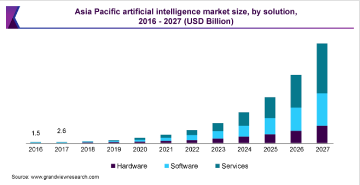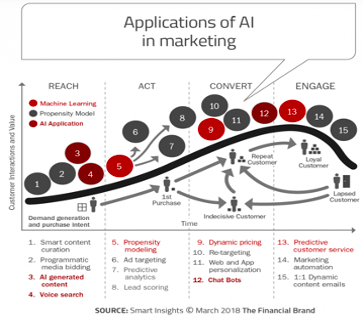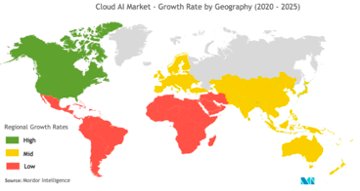Discover top data analytics trends in analytics and technologies to easily anticipate customer needs, personalize content, and achieve goals.
Without analytics, your company is vulnerable because analytics gives you valuable insight into what is and is not working. If your company doesn’t understand what mistakes it has made with its business decision-making, marketing performance, or customer interactions, it will keep on making those same errors. Data analytics helps business decision-makers position themselves in the industry and identify in which fields in their products and services are needed, why sales may have decreased or increased, and where there may be an opportunity in the market.
By using advanced analytics and technologies, a brand can easily anticipate customer needs, personalize its content, improve its bottom line, and achieve its goals. Companies are embracing analytics and systematic statistical reasoning to make decisions that improve efficiency, risk management, and profits while maintaining inventory, pricing solutions, or hiring talent.
Embedded analytics solutions (integration of analytical capabilities and data visualizations into another software application) enable businesses to take quicker action by putting analytics right into applications at the user level. Embedded analytics can simplify the process of generating insights and decrease the time needed to run data analysis and deliver actionable recommendations by making analytics accessible to key stakeholders, from customers to employees.
We all know how healthcare organizations have played the role of a frontline leader since the COVID-19 pandemic. In response to this emergency, more than 500 medical treatment and vaccination trials use a living patient database, compile and curate data from trial registries and other sources. These help medical health experts to predict the spreading of the disease, find a new method of treatment and plan for clinical management during this dire situation. Hence, we can say data and analytics combined with artificial intelligence (AI) technologies are paramount in the effort to predict, prepare, and respond in a proactive and accelerated manner to a global crisis and its aftermath.
According to Gartner, enterprises will start to overcome the 80% failure rate of ML deployment and successfully integrate it into a production environment.
Gartner research VP Rita Sallam also considers the below trends as the latest AI tech demand that will level up business in a new way in 2020.
1. AI With Smart Solutions
By the end of 2024, Data streaming and analytics infrastructure will drive a 5X growth and 75% of enterprises will shift from piloting to operationalizing AI. Gartner’s research VP Sallam also mentioned AI techniques like reinforcement learning, and distributed learning are creating more adaptable and versatile systems to handle complex business situations particularly now when pre-COVID models depend on historical data that may be valid no longer.

(NLP) provide crucial insights and predictions about the spread of the virus and the effectiveness and impact of countermeasures. AI and machine learning are now critically realigning supply and the supply chain following the new demand patterns. More significant investments have created new chip architecture like neuromorphic hardware that can deploy on edge devices. These solutions are accelerating AI and ML computations and workloads and reducing reliance on centralized systems that require high bandwidths. It leads to more scalable AI solutions have a higher business impact.
2. A Modified Version of Dashboard
According to Gartner’s prediction in 2025, Data stories (not dashboards) will become the most widespread way of consuming analytics that will replace visual, point-and-click authoring, and exploration. Researchers also mentioned one-third of these stories will be generated automatically using augmented analytics techniques.
Usually, in Dashboard, users must do a lot of manual work to dive into further insights. The shift to in-context data stories means the most relevant insights will stream to every user depending on their context, role, or use. These dynamic insights leverage technologies like NLP, augmented analytics, streaming anomaly detection, and collaboration. Automatically, the amount of time users spends using predefined dashboards will decline.

3. Decision-Intelligence Power of Better Decision-Modeling
Almost 33% of commercial enterprises will have analysts practicing decision intelligence with decision modeling by 2023.
Several disciplines, including decision management and decision support, come together in a single thread called decision intelligence. Gartner delineates decision intelligence as a practical domain that encompasses applications in the field of complex adaptive systems. Multiple traditional techniques (like rules-based approaches) and advanced disciplines (like AI and machine learning) come together with these complex adaptive systems.
Using the decision intelligence framework, data analytics leaders can design, compose, model, align, execute, monitor, and tune decision models and processes in the context of business outcomes and behavior.
4. X-Analytics
X- analytics the term first time coined by Gartner, where X denotes the data variable for a range of structured and unstructured content such as text analytics, video analytics, audio analytics, and more. Analytics leaders use this X analytics to solve complex problems, including climate change, disease prevention, and wildlife protection.

Gartner has mentioned, AI is now doing amazing jobs for video, audio, vibration, text, emotion, and other content analytics that will trigger large-scale innovations and transformations in 75% of Fortune 500 companies by 2025. As per the researchers, in the future, X analytics combined with AI and other techniques such as graph analytics (another top trend) will play a key role in identifying, predicting, and planning for natural disasters and other business crises and opportunities. Sallam said that AI techniques and their use in the cloud are maturing to expand adoption and the impact of X analytics.
5. Augmented Data Management
Organizations are now utilizing machine learning, data fabrics, and active metadata to dynamically connect, optimize, and automate data management processes which will reduce time to data delivery by 30% by the year 2023.
Augmented data management can convert metadata with the help of ML and AI techniques, from getting used in auditing, lineage, and reporting to powering dynamic systems. Furthermore, this product can examine a vast sample of operational data, including actual queries, performance data, and schemas.
Considering the above facts, data analytics leaders focusing on the augmented data management for enabling active metadata to simplify and consolidate their architectures, as well as increase automation in their redundant data management tasks.
6. A Better Platform With Cloud Technology
Businesses are expected to a 5X growth in cloud AI between 2019 to 2023 by making AI one of the top workload categories. The public cloud service market will be essential for 90% of data and analytics innovation. This trend started well before the pandemic, but COVID-19’s impact on the enterprise has certainly accelerated it. In the case of the cloud vendor, the more the cloud providers get you to do data and analytics in their cloud, the more you will do compute in their cloud. From the enterprise perspective, by embracing the new cloud stack, leaders can manage their work faster and in a better way.

At the same point, data and analytics leaders still struggle to align the right services to the right use cases that sometimes lead to unnecessary increased governance and integration overhead.
Hence, Data and analytics leaders should prioritize workloads that can exploit cloud capabilities and focus on cost optimization and other benefits such as change and innovation acceleration when moving to the cloud.
7. A Collision Between Data and Analytics Trends
Gartner forecasts near future, almost 95% of Fortune 500 companies will have converged analytics governance into broader data and analytics governance initiatives. Data analytics capabilities are distinct capabilities and are managed accordingly. Vendors are offering end-to-end workflows enabled by augmented analytics trends that blur the difference between once separate markets.
This collision causes interaction and collaboration between the separated roles of data and analytics. It will not only impact the technologies and capabilities provided but also the people and processes that support and use them.
But now it is up to the leaders and analytics service providers that how they will turn this collision into a constructive convergence, incorporate both advanced data-analytics tools and capabilities into the analytics stack. At the same time, they need to focus on people and processes to foster communication and collaboration.
8. Practical Implications of Blockchain
Researchers mentioned Blockchain technologies address two challenges of data analytics. It provides:
- The full lineage of assets and transactions.
- Transparency for complex networks of participants.
Blockchains aren’t inherently more protected than alternative data sources. Within the data and analytics realm, it’ll be used for vertically specific, business-driven initiatives like smart contracts. By 2021 Gartner projects the majority of the blockchain uses will be replaced by ledger DBMS products.
9. Data Marketplace and Exchanges
By 2022, 35% of large enterprises will be either buyers or sellers of data via formal online data marketplaces, up from 25% in 2020. These marketplaces and exchanges yield single platforms to consolidate third party offering. Moreover, these enable centralized availability and access to create economies of scale to reduce costs for third-party data.

At the same time, market leaders should establish a fair and transparent methodology to monetize data assets through data marketplaces by defining a data governance principle.
10. Relationship Between the Foundations of Data and Analytics Value
By 2023, 30% of the worldwide organization will utilize graph technologies to facilitate rapid contextualization for decision making. Graph analytics is a set of analytic techniques that explores relationships between entities of interest, such as organizations, people, and transactions.
After the COVID-19 pandemic, there is a high usage of graph analytics to respond to current and future pandemics. ML algorithms and new analytics trends have helped medical and public health experts rapidly discover new possible treatments.
Data and analytics leaders consider investigating how graph algorithms and technologies can improve AI and ML initiatives and evaluating new opportunities to incorporate graph analytics into their analytics portfolios and applications to uncover hidden patterns and relationships.
Analytics is the intrinsic nature of the business to keep evolving and preparing a better future for us. The future trends of data analytics playing a lead role in revolutionizing any business. Now it may be a question of how a business could align those data analytics trends to ensure success. Analytics service providers have made the situation easy with an intelligence-driven decision-making strategy. They apply Analytics vision and architecture to optimize business performance and decision support system to enhance organizational decision making. It is time to decide the best analytics approach for your business and achieve the desire position in a competitive industry scenario.